Community Training in Ecological Design
Starts Sept. 10

Sponsored by Finger Lakes Permaculture Institute, The Alchemical Nursery, and Cornell Cooperative Extension
| |
Learn a land use design method to improve home scale food and forest production, conserve resources, and save money.
Study basic ecological principles and methods and use them to solve problems on your own home and landscape.
The class will meet once a week to discuss the principles and techniques of permaculture and ecology that help us make better choices for our land, families, and communities.
Class work will include a self-selected design project. You can design your own backyard, garden space, vacant lot, field, forest, or even an entire neighborhood.
Examples and applications will be presented in both an urban and rural context.
To enroll, contact any of the sponsoring organizations.
There are scholarships available. If you want to contribute to help fund scholarships, contact Frank Cetera.
|
|
Weed volunteers needed
Saturday, July 23, 8:00 a.m. ~ submitted by Fran Lawlor
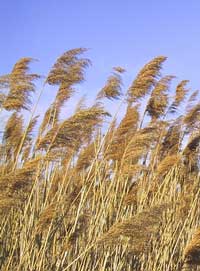 | |
Phragmites (Photo: michit - CC)
|
Elbridge Swamp is the largest preserve of the Central New York Land Trust (formerly Save the County). Carpenters Brook flows through this high quality, federally protected wetland. There is a small infestation of introduced Common Reed (European phragmites) in the western portion of the preserve, just at the edge of the federally designated wetland. It has expanded in two main patches, approximately a quarter acre each and in a couple of smaller patches.
The Land Trust is interested in non-chemical control of the phragmites to protect the water quality of the wetland complex. It has been shown that an annual cutting at the end of July will suppress common reed. Complete eradication using mechanical control is unlikely. The Land Trust wants to reduce the density of the common reed to encourage native plant species and associated wildlife. This is a once-a-year work project, for many years.
Bird species in the area: winter wren, great crested flycatcher, wood pewee, wood thrush, veery, pileated woodpecker, Baltimore oriole, and red eyed vireo. There are many black ash and tulip poplar along with some nice wetland plants.
To volunteer: Bring hedge clipper or hand pruners and wear long pants, long sleeves, work gloves and a sun hat (to keep away deer flies).
Saturday, July 23, 8:00 a.m. at the preserve. Contact Jeff Devine, CNY Land Trust, (315) 575-8839 .
|
| Interested in Edible Gardening? | 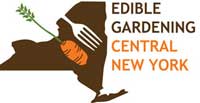
|
If you'd like to get information on Edible Gardening CNY, just send an email to John to find out about edible gardening tours and programs.
|
|
Join HGCNY!
|  |
Becoming an official member of HGCNY is easy: just join Wild Ones! When you're a Wild Ones member, you're automatically an official member of HGCNY. |
|
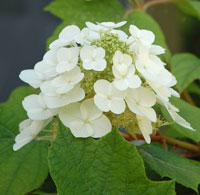 | Oakleaf hydrangea
(Hydrangea quercifolia) |
Greetings!
Time for Show Me, Help Me Tours
Summer is the time for our garden tours, which Wild Ones traditionally calls Show Me, Help Me tours. These aren't the kind of tours where you just admire beautiful gardens. These are tours where you learn from what the host has done and perhaps offer suggestions for any landscaping dilemmas they may have. Some of our tours have expert commentators, too. Our programs during the year are always interesting and informative, but there's nothing like seeing the results in people's yards!
PLEASE RSVP as soon as possible! Thanks!
Here are the dates:
Saturday July 23: in Westvale at the Allens
- 8 am habitat garden tour Due to heat, you're welcome to come at 8 am - 9 am edible garden tour
- 10 am habitat garden tour
Tour either or both. Sunday July 24: in Westvale at the Allens
- 4 pm habitat garden tour
Directions
Saturday July 30 at 2 pm in Fulton. This is a tour of a village lot backing up to a marsh. You can bring boots if you'd like to go into the marsh. Dan Carroll will co-guide the tour. RSVP to Linda, the host, with "Fulton Tour" as the subject.
Saturday August 27 in Jamesville - We will tour garden areas on a large rural property consisting of abandoned agricultural land and woods that have been harvested for timber over many years. RSVP to Randi, the host.
10:00 am: A long hike in the woods
11:30 am: A shorter garden tour near the house
Afterwards: You're invited to stay for a potluck picnic. Please bring your own table service, drink, chair, and a dish to pass.
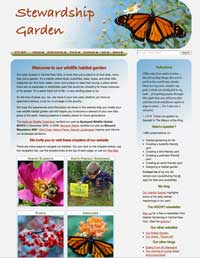 Meanwhile... Meanwhile...You can vicariously tour my own habitat garden by browsing through my website: OurHabitatGarden.org. You'll find lots of information about various creatures and how to provide habitat for them. Janet |
|
|
Guess the flower (answer below)
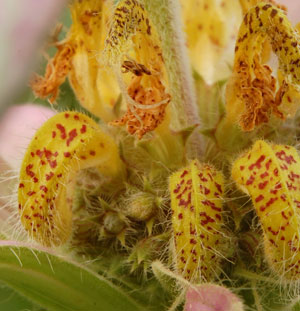 This is part of a very intriguing flower. |
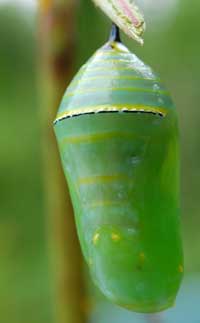 | | Monarch chrysalis |
Why does the monarch chrysalis wear a gold necklace?
No one knows for sure, but Karen Oberhauser, a University of Minnesota scientist who studies monarch butterflies, offers these possibilities:
a) Camouflage: they could reflect colors of the surroundings and break up the shape of the pupa; they might also look like dew droplets.
b) They may serve as warning coloration.
c) They might filter particular wavelengths of light which might be harmful to the developing insect.
d) They might not have any function, but just be the result of something else in the cuticle of the insect.
|
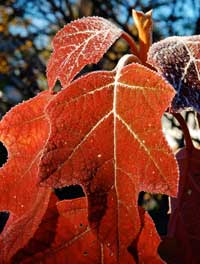 | Oakleaf hydrangea in fall
(Hydrangea quercifolia)
(See first panel above to see the flower.)
|
Plant woodies!
"One of the things you quickly learn about woody plants is the staggering number of birds, small mammals, insects, and fungi, not to mention people, that depend on them directly for their existence."
~ William Cullina,
Native Trees, Shrubs & Vines, p. 1 |
|
Update on unidentified weed
 | | Weed identified! |
Though it doesn't change the fact that this weed is everywhere in my garden, it's nice to know its name: Euphorbia peplus aka petty spurge. Thank you to Carol Bradford who correctly identified it, as well as to the other people who made some suggestions.
According to Wikipedia, the plant is originally from Europe, northern Africa, and western Asia, and it has invaded North America, Australia, and New Zealand. It has been used to treat warts, sunspots, and some research has shown it can treat superficial basal cell carcinomas.
|
|
Bad news: marmorated stinkbug
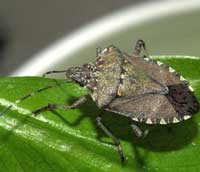 | | Photo: CC Wikipedia from invasive.org |
After submitting a sample insect to Cornell's Hudson Valley office, it was confirmed that this insect is indeed in Onondaga County.
For more info, visit our June 13 archived newsletter or go to Cornell Cooperative Extension's Hudson Valley office, which is studying this insect.
|
|
The mystery flower
The mystery flower is dotted horsemint (Monarda punctata). That's right - a type of monarda!
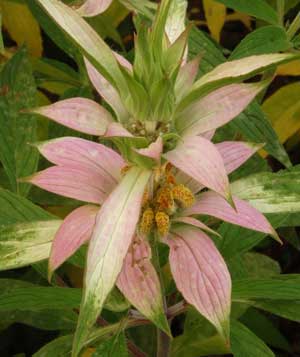
As you can see, the mystery image showed only one part of the flower. But to be more accurate, the first photo actually showed the flower, and this photo shows the flower surrounded by the colorful bracts, which on first glance might appear to be the flower. Similarly, poinsettias and dogwood "flowers" are actually the bracts.
I bought this at our plant sale last year. Be watching for details about this year's sale
September 10!
|
|
|
|
|